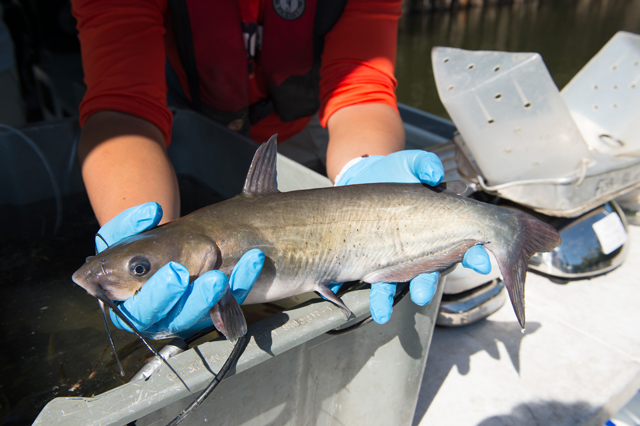
The channel catfish might be a catch of the day to some, but it’s only
one of an increasing fish population swimming in the Chicago area waterways
that MWRD staff catch throughout the year to document the aquatic life and
thriving ecosystem in local waterways.
A testament to the improvements in water quality in the Chicago Area Waterway System (CAWS) is swimming below the surface. The number of fish species found in the CAWS has drastically increased since the 1970s when monitoring of the fish population first began. From 10 known species in 1974, that number has ballooned to 76 in 2016, including 59 that have been found in the CAWS since 2000. Thanks in part to advancements at MWRD water treatment operations, the waterways have experienced decreases in levels of ammonia and biochemical oxygen demand (BOD). The BOD captures the degree of pollution by measuring the amount of dissolved oxygen (DO) that must be present in water for microorganisms to break down organic matter in the water at a certain temperature over a time period. These water quality improvements have proven to be essential factors for nurturing aquatic life, while the MWRD’s Tunnel and Reservoir Plan has also helped reduce the amount of combined sewer over flows (CSO), leading to less polluted water and healthier homes for freshwater fish living in the CAWS. Since the tunnels became operational in 2006, the amount of CSOs has been reduced from an average of 100 days per year to 50.
These 76 fish species include 28 game fish and 45 native species. MWRD staff have come across a variety of fish in the CAWS, including the walleye, northern pike, yellow perch, grass pickerel, freshwater drum, and white and yellow bass. Other fish demonstrate the significance of water quality improvements in the CAWS. The banded killifish, for example, is listed by the Illinois Department of Natural Resources (IDNR) as a state threatened species, yet MWRD aquatic biologists have been able to identify an increasing number of the banded killifish pulled from the CAWS. In 2014, the IDNR was conducting an electrofishing survey on the North Shore Channel and discovered a spotted gar. Spotted gar is usually found in the lower portions of Illinois and this is the first time this fish has been spotted in the CAWS. For a complete list of fish species collected by MWRD in the CAWS, click here.
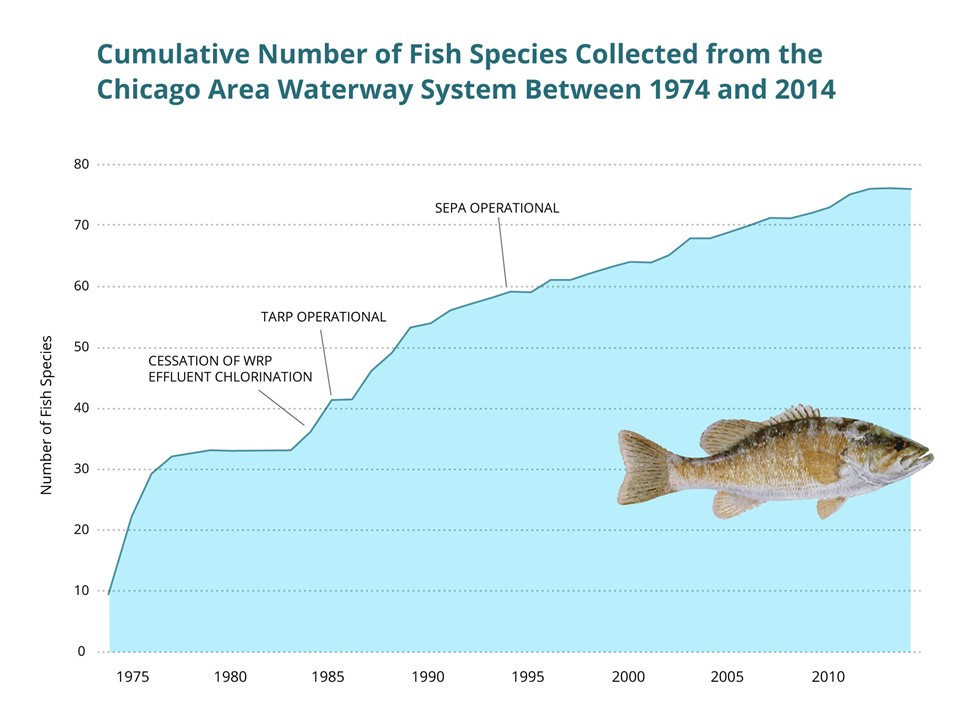
The number of fish species has shown a steady increase following the
implementation of the Tunnel and Reservoir Plan and Sidestream Elevated Pool
Aeration stations. The MWRD now uses chlorination/dechlorination to
disinfect effluent at its Calumet Water Reclamation Plant, and UV
disinfection at its O’Brien Water Reclamation Plant.
MWRD aquatic biologists collect and monitor aquatic life through fish surveys. The MWRD conducts fish monitoring periodically at 28 locations throughout its service area, which includes the Chicago, Calumet, and Des Plaines River Systems. Electrofishing is one of the commonly used tools that MWRD biologists employ to collect fish data, such as abundance, composition, and diversity. In boat electrofishing, the boat’s hull acts as a cathode, while the anodes are on the electrofishing booms which project from the front of the boat, releasing direct current electricity between the submerged cathode and anode. After the current goes into the water, the fish are briefly stunned, affecting their swimming, and MWRD staff collects them in nets and places them in a tank on the boat. They weigh, measure, and inspect fish for disease and other anomalies before releasing the fish back unharmed into the water. While MWRD staff frequently monitors and tests water samples taken from the MWRD service area waterways, MWRD biologists also study the fish to discern the impact of the Tunnel and Reservoir Plan (TARP) and biological effects of water downstream of plants where the treated water is released.
As water quality improved over the decades, the abundance and diversity of fish species increased based on MWRD fish collection data, The MWRD collected increased numbers of desirable game fish species in the 1980s through the 2000s compared to the 1970s. Fish species like the largemouth and smallmouth bass, bluegill, sunfish, pumpkinseed, green sunfish, black crappie, rock bass, and channel catfish were scarce or absent at some locations within the CAWS in the 1970s but have become more abundant as water quality improved.
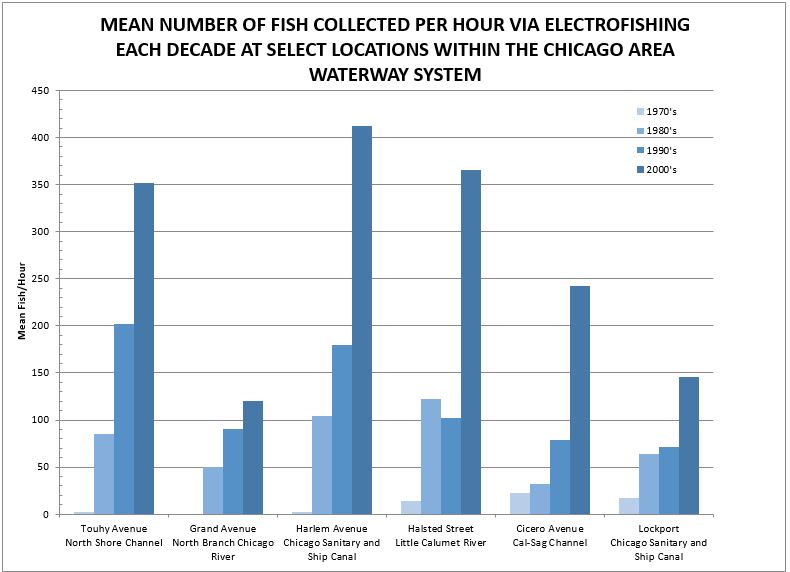
The mean number of fish collected in the 1980s more than tripled at four
locations by the 2000s, while the mean number collected has steadily
increased over the last 40 years in all six locations listed above. The fish
catch per unit effort measures the abundance of fish caught at one location
among varied species.
Fish like the channel catfish are also experiencing a resurgence because of MWRD partnerships that not only work to improve the water quality but also the habitats of these fish. The MWRD is a participating funder of the popular Chi-Cal Rivers Fund, which assisted the Friends of the Chicago River (FOCR) to create channel catfish habitats in the Chicago River system. As a result of proceeds from the Chi-Cal Rivers Fund, the FOCR, with support from the Illinois Department of Natural Resources (IDNR), designed and installed 400 constructed nesting cavities and released 195,000 juvenile channel catfish that will grow up with the opportunity to use the nests. This program will allow the critical species to repopulate the river after years of degradation limited its breeding success. About 30,000 channel catfish were released at the MWRD’s Devon Avenue Instream Aeration Station. The FOCR and IDNR released another 110,000 fish into the Little Calumet River near Whistler Woods Forest Preserve. To improve the habitat for future channel catfish reproduction, the 400 nesting cavities were installed in the Little Calumet, North Branch of the Chicago River and North Shore Channel. These nesting cavities are 15-inch, permeable concrete tubes that act as underwater shelters to help the channel catfish populate the system. After a few years of maturing in CAWS, the female will deposit her eggs in the nesting cavities and the male will stay around to guard the eggs. The MWRD is one of 10 members of the public-private partnership created through the Chi-Cal Rivers Fund that also works to support green stormwater infrastructure. Since 2013, the fund has awarded 15 projects that have received a total of $3.5 million in grants.

Channel catfish, about 4-5 inches in length, were shot from hoses into Chicago Area
Waterways as part of a spawning habitat restoration project made possible
through the Chi-Cal Rivers Fund. The hope is that the 1-year-old catfish
will mature and reproduce after a few years utilizing newly installed
nesting cavities.
The FOCR also received a grant from the Chi-Cal Rivers Fund to install native emergent vegetation in the North Shore Channel and the North Branch of the Chicago River as habitat for fish and other aquatic species, which creates high-quality habitat for aquatic organisms, protects the shoreline from bank erosion, creates shelter for aquatic life during floods, and improves the aesthetics of the channel for recreational users. To accompany this new habitat, the IDNR also stocked the North Shore Channel with more than 4,000, 5-inch Northern Pike in 2016. Northern Pike, a fish species associated with aquatic vegetation, will take advantage of the new habitat and provide opportunities for urban anglers.
There are several reasons for the water quality improvements in the CAWS that have made a suitable home for the increasing fish population. TARP, also known as “Deep Tunnel,” provides additional capacity to store combined sewage and stormwater that would otherwise discharge into local waterways. By 2029, TARP tunnels and completed reservoirs will have the capacity to hold 20.55 billion gallons of water. In addition, the MWRD has developed in-stream and side-stream aeration systems that have also provided much needed oxygen to aid in water quality improvements. As part of this innovation, the MWRD installed Sidestream Elevated Pool Aeration (SEPA) stations located along the Calumet-Sag Channel and the Calumet River. The five stations serve as scenic public recreation spaces and also improve the water quality and create new life in the CAWS. These waterfalls pump up to 1.3 billion gallons of water per day and add up to 25 tons of oxygen to the waterways each day. At the stations, up to half of the river's flow is pumped up as high as 17 feet to an elevated, shallow pool, from which the water then cascades over a number of drops back into the waterway. The waterfalls aerate the river water and enhance the aquatic environment by improving and protecting fish populations and eliminating odors. During colder months when water temperatures are lower, DO levels are generally high enough that pumping is not needed, but during summer months when the warmer water has less capacity for dissolved oxygen, the aeration process can improve DO levels.
From its days as primarily a sewage canal and dumping ground, the Chicago River and entire CAWS have made remarkable strides. In the last 40 years, the MWRD and the river’s stakeholders have transformed it into a starring attraction for economic and recreational rebirth. Increased fish populations illustrate improved water quality and have sparked a renewed interest in the waterways. The improved health of the local water environment has led to new opportunity for decades to come.
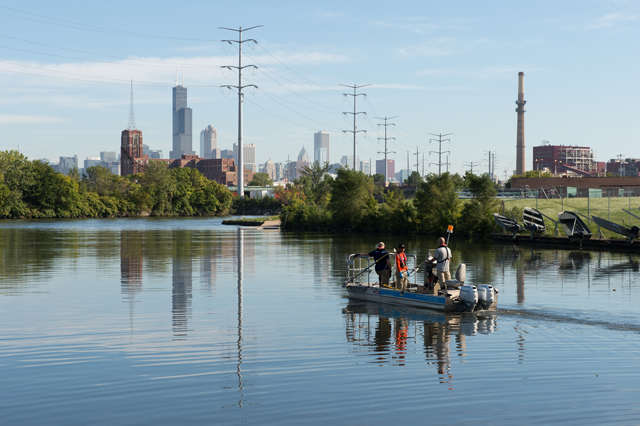
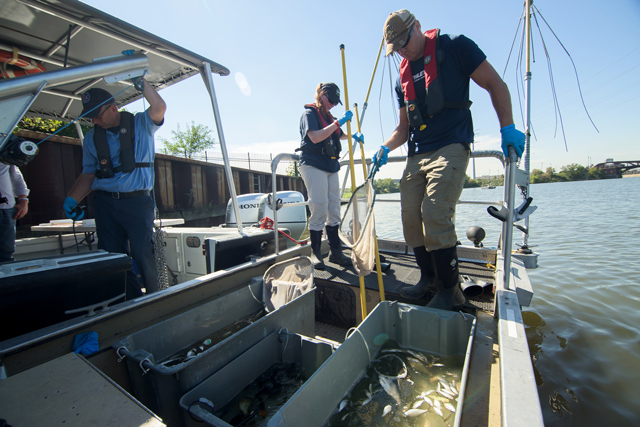
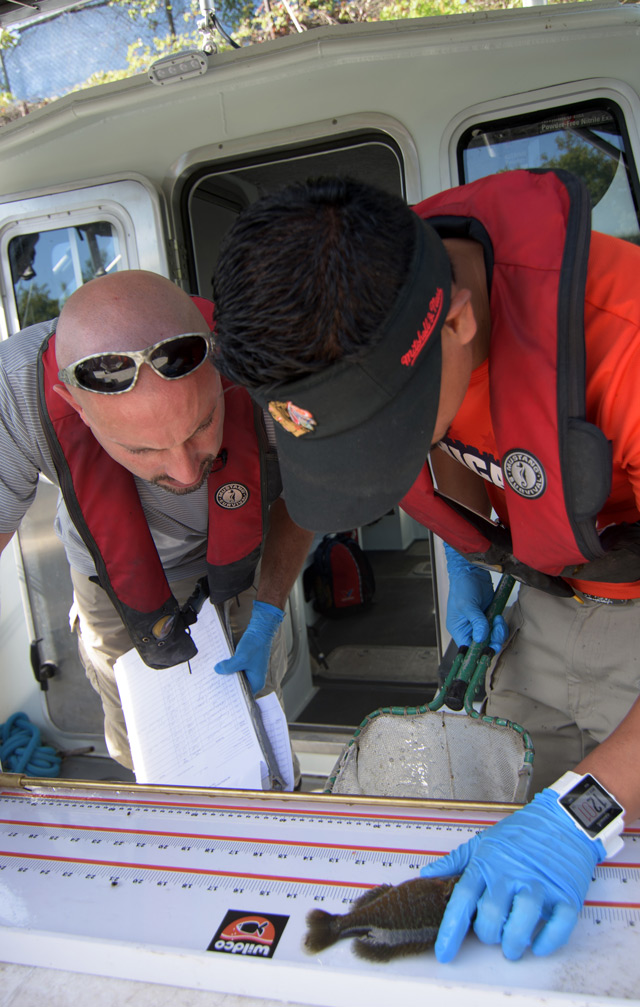
A team of MWRD aquatic biologists and research
technicians survey the Chicago Area Waterways often to study the fish
populations in the waterways. They are seeking to find new species, while
also monitoring the abundance of existing species.
The MWRD encourages fishermen to enjoy recreating on
the CAWS while following the local IDNR advisories for fish consumption
found
here.
To learn more about fishing in Illinois, visit
www.ifishillinois.org.